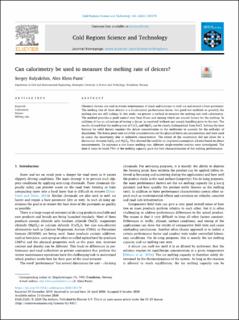| dc.contributor.author | Kulyakhtin, Sergey | |
| dc.contributor.author | Klein-Paste, Alex | |
| dc.date.accessioned | 2021-06-03T09:04:29Z | |
| dc.date.available | 2021-06-03T09:04:29Z | |
| dc.date.created | 2020-12-01T17:26:11Z | |
| dc.date.issued | 2020 | |
| dc.identifier.citation | Cold Regions Science and Technology. 2020, 181, . | en_US |
| dc.identifier.issn | 0165-232X | |
| dc.identifier.uri | https://hdl.handle.net/11250/2757508 | |
| dc.description.abstract | Chemical deicers are used in winter maintenance of roads and runways to melt ice and restore a bare pavement. The melting rate of these deicers is a fundamental performance factor, but good test methods to quantify the melting rate are still lacking. In this study, we present a method to measure the melting rate with calorimetry. The method provides a good control over heat fluxes and mixing which are crucial factors for the melting. In addition, it has an advantage of testing a deicer ‘as received’ without any sample handling prior to the test. The results showed that the melting rate of CaCl2 and MgCl2 can be clearly distinguished from NaCl. Solving the heat balance for solid deicers requires the deicer concentration in the meltwater to account for the enthalpy of dissolution. The freeze point and solubility concentrations set the physical limits on concentration and were used to assess the uncertainty due to unknown concentration. The extent of the uncertainty did not allow for a distinction between CaCl2 and MgCl2. This showed the need for an improved assumption scheme based on direct measurements. To represent a non-linear melting rate, different single-number metrics were investigated. The time it takes to reach 75% of the melting capacity gave the best characterization of the melting performance. | en_US |
| dc.language.iso | eng | en_US |
| dc.publisher | Elsevier Science | en_US |
| dc.rights | Navngivelse 4.0 Internasjonal | * |
| dc.rights.uri | http://creativecommons.org/licenses/by/4.0/deed.no | * |
| dc.title | Can calorimetry be used to measure the melting rate of deicers | en_US |
| dc.type | Peer reviewed | en_US |
| dc.type | Journal article | en_US |
| dc.description.version | publishedVersion | en_US |
| dc.source.pagenumber | 8 | en_US |
| dc.source.volume | 181 | en_US |
| dc.source.journal | Cold Regions Science and Technology | en_US |
| dc.identifier.doi | 10.1016/j.coldregions.2020.103170 | |
| dc.identifier.cristin | 1854995 | |
| dc.description.localcode | This is an open access article distributed under the terms of the Creative Commons CC-BY license, which permits unrestricted use, distribution, and reproduction in any medium, provided the original work is properly cited. | en_US |
| dc.source.articlenumber | 103170 | en_US |
| cristin.ispublished | true | |
| cristin.fulltext | postprint | |
| cristin.qualitycode | 2 | |

